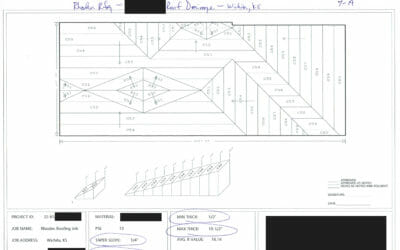Introduction – Happy Tenants & Smooth Projects
The number one point of tension between management and tenants on large roofing projects is parking & traffic. Over the years of performing large-scale roofing projects at apartment complexes, tenant-commercial, HOA communities, rehab centers, and self-storage, one thing is very clear; happy tenants = smooth projects.
Parking and traffic are so crucial to the daily lives of tenants and property vendors (landscape, trash, mail), that poor planning or execution here is tantamount to failure on a project.
Managing parking and traffic during multifamily roofing projects is crucial for minimizing disruption and ensuring the safety and satisfaction of residents. This instructional guide is a collection of best practices from our roofing project managers. Originally documented internally to help our team learn from each other and ensure constant improvement on our projects, we now share this as a guide for multifamily property owners and managers who are facing a large upcoming construction project. Projects at this scale are (if you’re lucky) rare, so many property managers have not faced the challenge of preparing a project with this level of impact on their community before.
1. Understand Building Flow:
- Building flow refers to the sequence in which roofing work is scheduled for different buildings within your multifamily complex.
- It’s essential to have a plan in place to ensure a smooth and organized progression of the roofing project.
- Start at Prominent Locations: It’s advisable to begin roofing work with buildings located in more prominent areas of the complex, close to entrances or common areas. This helps ensure that residents are immediately aware of the ongoing roofing project.
- Consult the site map: Utilize the multifamily complex’s site map to visualize the layout of the buildings and parking areas. Determine which buildings will be addressed first and how the project will progress sequentially.
2. Early Communication with Roofing Contractor:
- Initiate early communication with your roofing contractor to discuss the roofing project’s timeline, the order of work, and potential disruptions to parking and traffic.
- Understand what equipment your roofing contractor will need and access requirements. Different projects have different requirements, and if a crane is needed, you will have additional permitting and access requirements. Get ahead of understanding needs for your property by learning more at What Equipment is Used During Multifamily Roofing Projects?
- Define temporary parking zones. Work with your roofing contractor to designate temporary parking areas nearby, if feasible. This can help alleviate the parking shortage during the project.
- Coordinate with your roofing contractor to establish specific times when parking areas will be restricted or unavailable. Aim to schedule these restrictions during off-peak hours when residents are less likely to need their vehicles.
- Reserved Parking: Consider designating reserved parking spaces for roofing crew members, ensuring they have easy access to equipment and materials without disrupting the entire parking area. It is often less disruptive to have everything in one place at a time rather than spread out or mixed in with tenant parking
3. Communicate Sequential Progression to Tenants:
- Create a clear plan (building flow, discussed above) that outlines the sequential progression of roofing work from one building to the next – and communicate this order to tenants
- Share updates to this plan with residents to keep them informed about what to expect as the project advances.
- Use various communication channels, such as notices, emails, and in-person meetings, to inform residents about the roofing project’s schedule.
- Offer a single phone number for anyone to call related to equipment, access, or parking. Depending on the project, this may be the on-site property manager, or could be the on-site project manager/foreman of the roofing contractor
4. Considerations for Shared Spaces:
- For shared spaces like clubhouses, pool houses, and parking garages, be intentional about choosing the best days and times for roofing work to minimize tenant disruption.
- Communicate with your contractor to know if you can work weekends to avoid tenant disruption at critical buildings on your property, and to know what individual building timelines are for larger buildings
5. Coordinate with Other Trades:
- If other trades are working within the complex, such as landscaping or trash removal, coordinate with them to ensure minimal interference with their operations.
- For shorter projects (completion timeline of 1 week or less), consider starting roofing work the day after mowing. This keeps less equipment in the area, and also shorter grass is less likely to hold roofing nails or debris down to the point that a roller magnet will not be able to pick it up.
6. Be Proactive with Communication:
- Proactive communication can prevent stress and conflicts down the road. Always provide advance notice of the project’s timeline and any potential disruptions.
- See our educational piece dedicated to effective Tenant Communication Tips Ahead of and During Multifamily Roofing Projects.
- Signage and barriers: Place clear and visible signage to indicate parking restrictions and detours. Use traffic cones or barriers to mark off areas that are off-limits.
- Resident feedback: Encourage residents to provide feedback on the parking and traffic management during the roofing project. Share this input with the contractor during the project, and use the information to improve future planning and communication efforts.
7. Cleanup: Nails & Tires:
- Roofing nails are particularly prone to making flat tires. Plastic-cap nails, which are required by code and used to hold down roofing underlayment, have a wide plastic flange that holds underlayment in place. Unfortunately, that flange also works great for positioning a fallen nail pointing up, making them a menace for tires.
- Insist that your contractor use roller magnets throughout tear-off and installation, and at the end of each day. This will pick up any stray nails that make it to the ground
- Be proactive about nails by working with a contractor who keeps debris at roof level, and uses property protection such as lift trailers, cargo nets, or tarps during tear-off.
- People, Pets, and Property protection. See our main piece on Safety Planning for Overhead Roofing Work at Multifamily Tenant Properties
Conclusion:
Efficient parking and traffic planning during multifamily roofing projects are essential to maintaining resident satisfaction and safety. By communicating effectively, implementing temporary solutions, and prioritizing resident needs, you can minimize disruptions and ensure a smooth roofing project experience for all stakeholders. Remember that clear communication and careful planning are key to success.
This article is part of our Multifamily Roofing Comprehensive Planning Guide. Learn more about:
- Ensuring Smooth Projects
- Know Before You Start
- Common Challenge Areas
- Related Education



